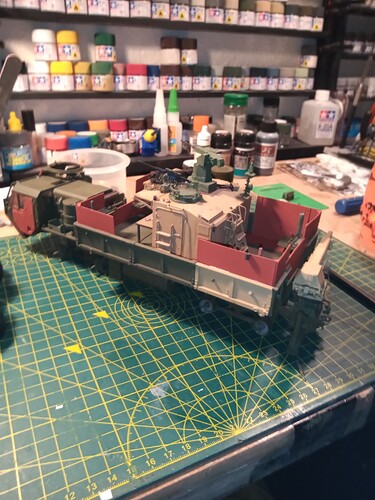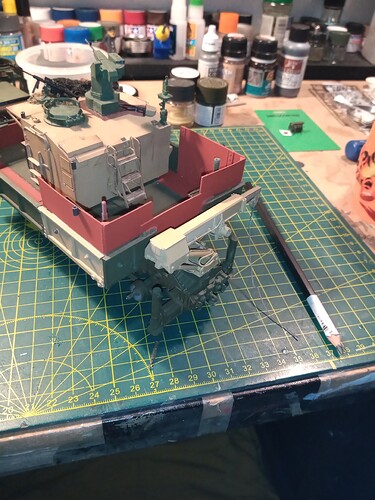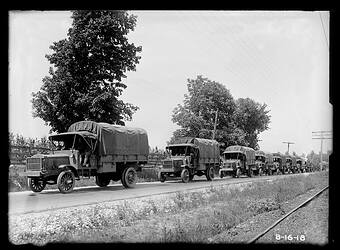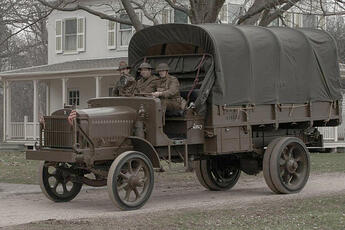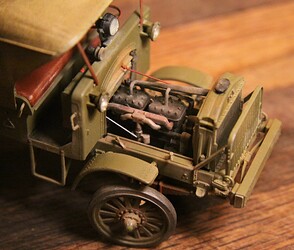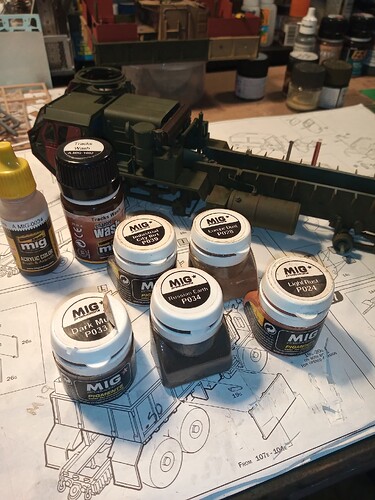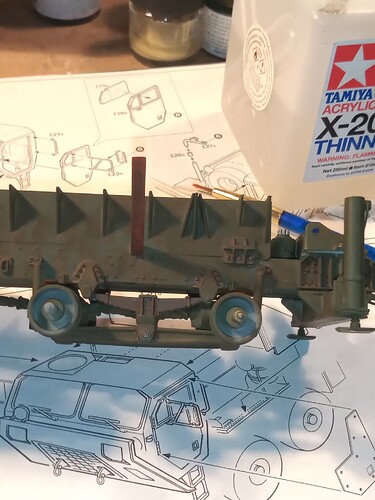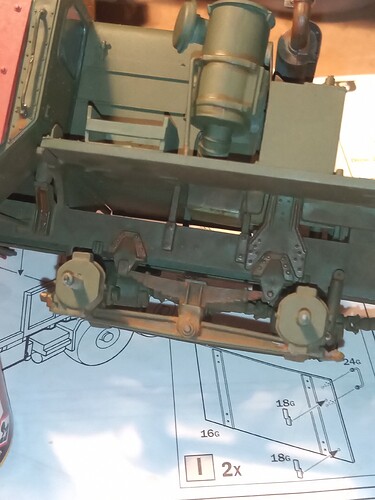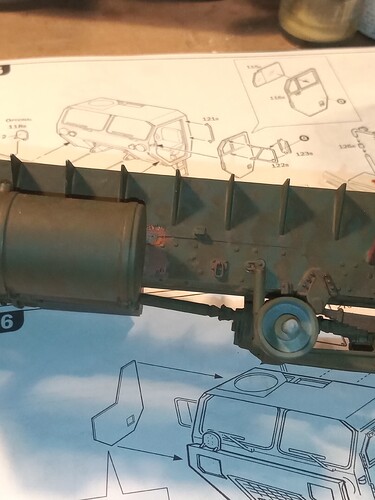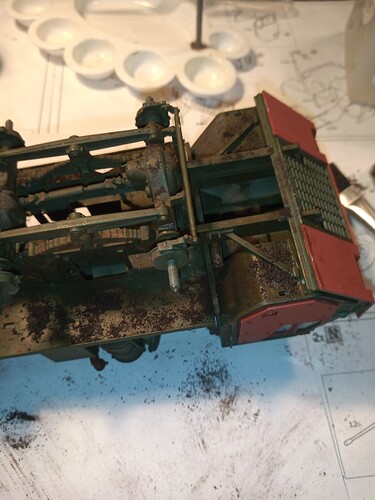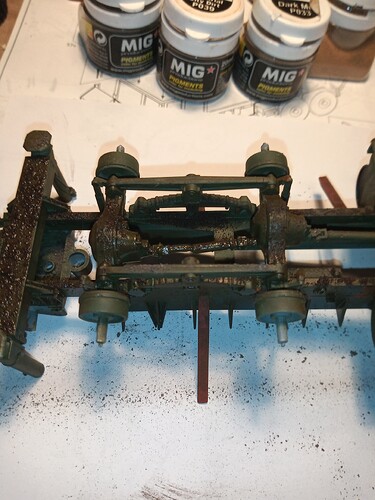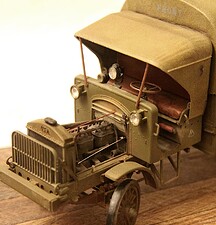Now, the Raven and Apache have both got Matt clear coats on… Going to let that fully dry …
So, it’s gun truck time 
To get back in the groove, I mocked it up less the wheels…
Already have a few ideas about how to move it forward
Sadly I will be attempting to weather out the chassis, it is even more depressing now that Damian has showed his artistic brilliance in how he tackled his rusted and worn chassis… So once I try and do mine, I will be hiding it under 6 tons of mixed earth pigments lol…
Once that is done, a dirt and light dust wash, then the wheels on and the same process for those.
Then I will assemble the weapons and get those sorted on the various mounts…
Still to do is the umbrella for the cab MG mount, decided on what sort of cam net/ cover to have on the rear section behind the box body… I may not bother adding wheel armoured plates to the sides… Anyway… That’s sort of the plan…
6 Likes
Probably for economy (the First Series electrical system wasn’t actually needed) and simplicity, or to avoid unnecessary possibilities of bottlenecks in the supply chain. It’s been suggested that while Abner from Backwoodsville could adapt to the High-tech Acetylene stuff electrical systems were a bit too Rocket Science; flashlights were still a novelty only just maturing as a technology and I think battery lanterns were only around from about 1914. The inconveniences of Acetylene vice electricity may not have been significant to people who were used to oil lamps. And with carbide you can have exploding seagulls…
Regards,
M
1 Like
The model instructions are unclear on this but i don’t believe the earlier series had the searchlight as it being unnecessary given the brighter electric headlights. (Not sure on this.) The earlier series certainly did not have the acetylene generator so either the searchlight was electrified or was not there at all.
As to gravity feed fuel systems that was the norm for the day. No fuel pumps yet.
As to the electrical system on the early trucks: There was no battery and no electrical generator per se, rather it had a magneto. (Just like on a pull start lawn mower.) No starter, just hand crank. If the engine was not running there would be no juice coming out of the magneto so no lights at all.
- Early series - with electric lights, no gas generator and no searchlight:
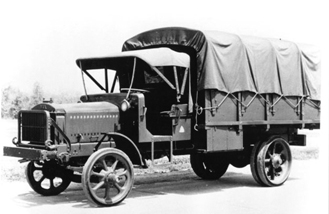
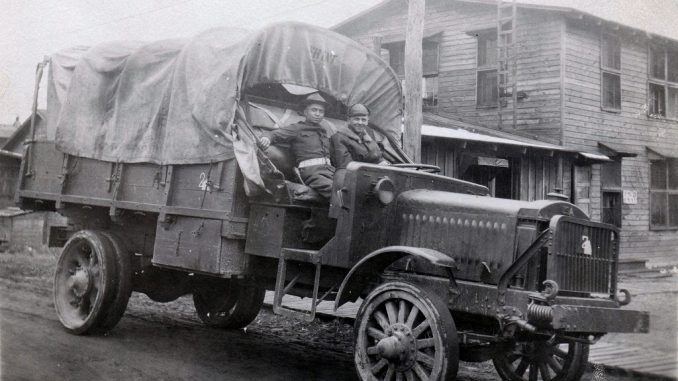
- Later series: Oil fired carriage lights, “SOLAR” gas generator and searchlight:
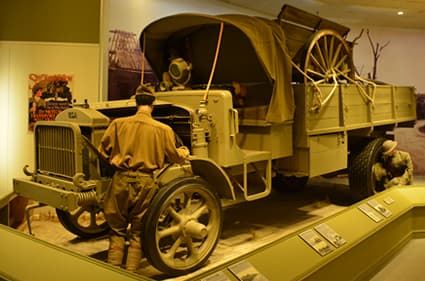
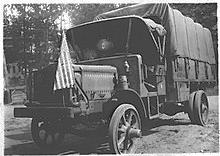
I so liked the extra detail of the searchlight that I still used it on my early truck and just said “oh what the heck” it’s electrified!
The item next to the searchlight is the “Aah-uug-gah” manual horn.
The First Series had a plug connection socket on the dash to attach an inspection lamp so that would not be a problem. The First Series did have a magneto only ignition system but unlike the Second Series it also had a complete separate electrical system with battery, generator, distributor and a second set of spark plugs which could be switched on if the magneto system failed (some sources suggest they could actually run simultaneously). The First Series also had an Ammeter on the dash with a switch cluster; these were absent on the Second Series. So your truck is within the bounds of possibility as an unofficial field modification.
Regards,
M
Are you sure about the battery and generator? On the engine photos i see a magneto but no generator.
Going in for a sympathetic rust on the chassis…
Then going to mix up these pigments and dirty up the chassis and seal it in…
5 Likes
The first series did have a “dynamo” or generator and a battery. This would make it easier to start as there would be a good spark on even the mildest of swings. I do not know if both systems were used simultaneously as in an airplane or if the system was switched from BAT to MAG as on a Model T. In the Ford the mag provided a hotter spark once the engine was running and when switched the motor picks up speed. Here are pics of the generator on the first series Liberty motor:
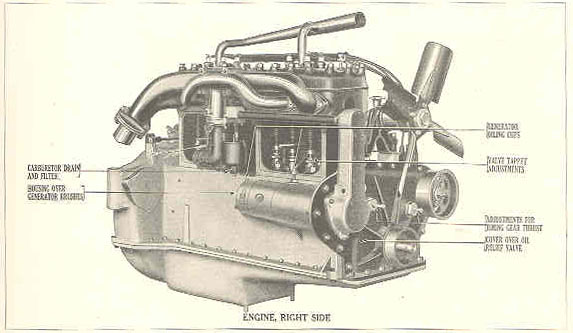
Paul
1 Like
As to what the Liberty Trucks had I reread the Wiki page. Both ignition systems were used at the same time and this makes sense. With two plugs per cylinder it would have to be to keep the unused set of plugs from fouling. Motors of this vintage had very low compression ratios and there was a lot of carbon fouling in the cylinders. A decarbon & valve grind was a part of annual maintenance.
As to the searchlight, I think it makes sense that these were added for the second series when the electrical system was dropped.
Series I
-
Battery, generator and distributor with electrical lighting system, in addition to the independent [magneto ignition]
-
Distributor and magneto systems with independent sparkplugs and wires (two per cylinder)
-
Ball and coil spring device to hold starter crank up in front
-
Primarily wooden spoke wheels vs. more robust steel wheels but Steel wheels were issued on 1st variant in later production
-
Single clamp hold-down radiator cap threaded in the center into the radiator
-
Electric side lights
-
Electric Guide lights up front on the frame horn members inside wheel area
-
Electric tail lamp
-
Electrical troubleshooting lamp plug in dash
-
Dual ignition switch on dash for battery and magneto ignition simultaneous operation.
-
Ammeter in dash switch cluster (lights/battery/mag, the gauge and a plug socket for a trouble light)
-
Single dash-mounted fuel tank which gravity fed the carburetor
Series II
-
Pressed steel spring clip to hold starting crank, vs. ball under spring clamp
-
Carbide Gas illuminated spot/driving light in the center of the dashboard powered by ‘Solar’ brand gas generator
-
Oil wick illuminated side lights (possible transition from electric as they dropped the battery system)
-
Oil wick rear taillamp
-
Spring-mounted oil fill caps raised to vertical level for easier filling on suspension
-
Oil filler for engine moved to rear of block
-
Radiator uses flip-type cap with hinge to rear and lock bolts on the sides
-
Reserve fuel tank under passenger seat
-
Manual fuel transfer hand pump on extreme right of cab for transferring fuel from the underseat-mounted reserve tank to primary dash mounted tank (co-driver job)
Paul
1 Like
Got some rust on the chassis and box body… And started the dirty phase
Will just show one side as both are pretty much the same.
Used mig track rust liquid and mig light rust pigment
Then flipped it over and mixed that cocktail of earth pigments and started putting a layer down on the underside
A few places are wet still.
Will let these pigments fully dry off then do both sides of the chassis and seal it with a Matt varnish
6 Likes
Well I stand as educiated as to the Liberty Truck!
Sweet!
New question/different topic.
Is that double wide loadbox on the HEMTT Gun Truck a real thing?
Just asking. Trying to learn things.
So, Tom; how was voltage regulation handled in the Series 1 Liberty Trucks?
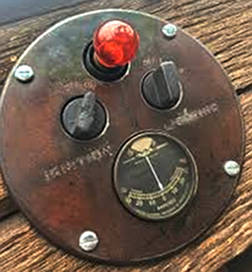
I am just guessing that the generator fed it’s varying voltage right into the coil and into the lead-acid (unsealed) battery and any excess charging voltage not needed by the battery was simply boiled off thru heating of the battery electrolyte. I guess that might be another good reason for having those 6 vent holes drilled in the seat box. (I assume too that the battery was under the seat as I have not seen it located anywhere else on the vehicle.)
2 Likes
No, just his post-apocalyptic concept vehicle. Pretty cool though.
1 Like
I added transmission shift linkages, rear wheel mechanical brake links and bell cranks plus some missing rear framing around the towing pintle. Also canted the front wheels.
Also added additional wiring to the engine and firewall plus engine throttle and spark advance control rods and radiator brace. (Based on current findings I am not saying all these details are exactly correct.
Assembly at Diamond T plant.
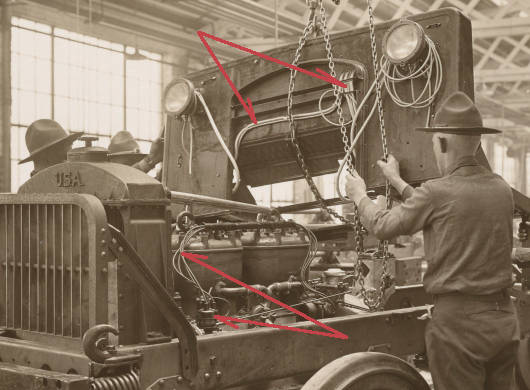
1 Like
Thanks Gino
Yes very cool.
Just wondered for a moment if something like this had existed perhaps as a field mod.
1 Like
Sorry, that’s outside my pay grade. Anything that happens under the lid at the front of my car is a mystery to me. I take it to the dealership once a year and if anything happens between visits I just ring the recovery service. I don’t even try to wire the motors on car kits…


Cheers,
M
Sir, you have not truly known life until you’ve spent it beneath a VW bus adjusting the valves.
2 Likes
Michael, as Gino said, its just my over active imagination I’m afraid.

Theres the before paint look. main centre panel is the kit cargo bed. I then added extensions to either side (the sand coloured side is actually Panther side skirts and the other is just white plastic sheet cut to length).
I then tried to add some sort of (poor) weld line to them and then I cut the front and rear upright panels in half and added more plastic sheet to get the width right.
I only bothered to do this so I could add the box body section from the Pantsir onto the cargo bed.
4 Likes
![]()
